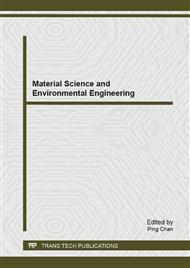p.244
p.248
p.256
p.260
p.269
p.276
p.282
p.286
p.291
Drug Sustained Release Multiple-Component Polymeric Microparticles Fabricated Using an Electrospray Process
Abstract:
The present study investigates the preparation of ferulic acid (FA) sustained-release cellulose acetate (CA) microparticles, in which a third component, polyvinylpyrrolidone (PVP), was included into the microcomposites for an improved sustained drug release profile. An electrospraying process was exploited for the fabrication of multiple-component microparticles. Under an applied voltage of 18 kV, FA/PVP/CA composite microparticles were successfully generated. Field emission scanning electron microscopic observations demonstrated that these microparticles had an indented surface morphology with an average diameter of 1.71 ± 0.56 μm. The drug presented in the polymeric microparticles in an amorphous state due to the favorable secondary interactions among the components, as verified by the X-ray diffraction (XRD) patterns and attenuated total reflectance Fourier transform spectra. The triple-component microparticles could provide a fine sustained release profiles with full release completeness and small tailing-off release time period. The electrospraying process is a useful tool for developing sustained release microparticles and multiple-component co-existence in the microparticles can be taken to adjust the sustained drug release profiles.
Info:
Periodical:
Pages:
269-275
Citation:
Online since:
May 2014
Authors:
Price:
Сopyright:
© 2014 Trans Tech Publications Ltd. All Rights Reserved
Share:
Citation:


